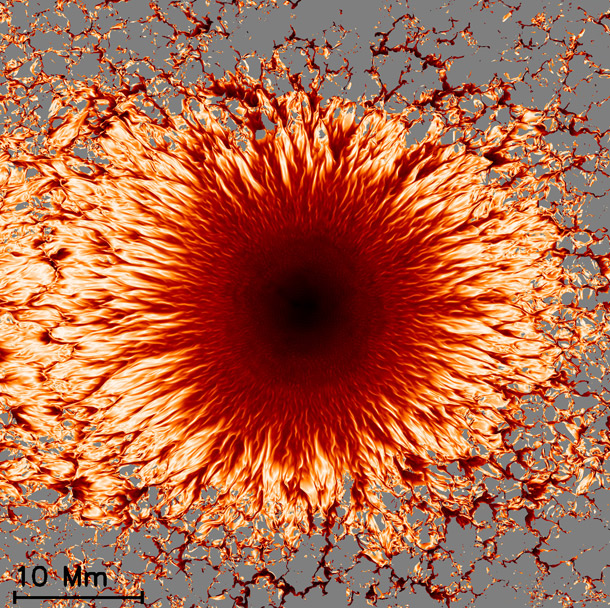All the astronomy sites are buzzing over this amazing image of a sunspot:
 |
| Click to embiggen. |
I don’t blame them… it’s gorgeous! And it’s not even real! It’s a computer-generated model of the magnetic field in a sunspot; near the center the field lines are mostly vertical and around the edges they are mostly horizontal.
But to me, as a scientist as well as an appreciator of gee-whiz images, it’s this shot that tickles my brain:
Click it to see it cromulently embiggened.
I know, it doesn’t seem like quite as much to look at, but it is: it’s the first time a computer has modeled in detail the magnetic field line strengths of a pair of coupled sunspots vertically, in three dimensions, into and beneath the surface of the Sun!
Wow. You have to understand, magnetic fields are the devil’s own work to model; they’re fiercely complicated. The equations are tough enough to solve, but the field lines interact with one another as the gas moves around, making this sort of modeling just as painfully hard as it could be. We understand quite a bit about sunspots in general, but in detail they are still a mystery; models like this will help us grasp those details. The resolution is incredible; the computer modeled points in the virtual Sun just 10 to 20 miles apart. That meant it needed to keep track of nearly two billion points.
That image is amazing, and beautiful. The way they colored it, it looks like a slice beneath the Earth’s surface… but the width of that image is far larger than the Earth itself. As for the science, check out this animated sequence to see just how this simulation allows scientists to understand the movement of the gas in a sunspot, too. You can see the gas flowing outward from the center, and the convection inside the Sun driving parcels of gas up and down.
Holy crap.
And just as amazing is the computer itself that did this work: NCAR’s Bluefire, which can perform 76 trillion calculations per second.
I’m glad they didn’t name it Skynet.
This comes at a time when we’re starting to understand how streams of gas under the Sun’s surface relates to its overall sunspot cycle. All of this has been a huge mystery for centuries, and we now live in a time of accelerating understanding of the Sun. And, on top of all this, due for launch later this year is the Solar Dynamics Observatory, a highly sophisticated spacecraft that will study our nearest star in better detail than ever before.
This is a great time to be a science geek. Revel in it.
Oh, and to the Plasma/Electric Universe believers who always froth and foam about how “mainstream” scientists don’t understand magnetism and plasma: you’re looking increasingly marginalized, dudes. You might want to look into a new line of work, like UFOs, or 9/11 theories. Science makes progress while pseudoscience makes excuses… and your field (“field”! Oh man, I slay me!) is looking weaker every day.